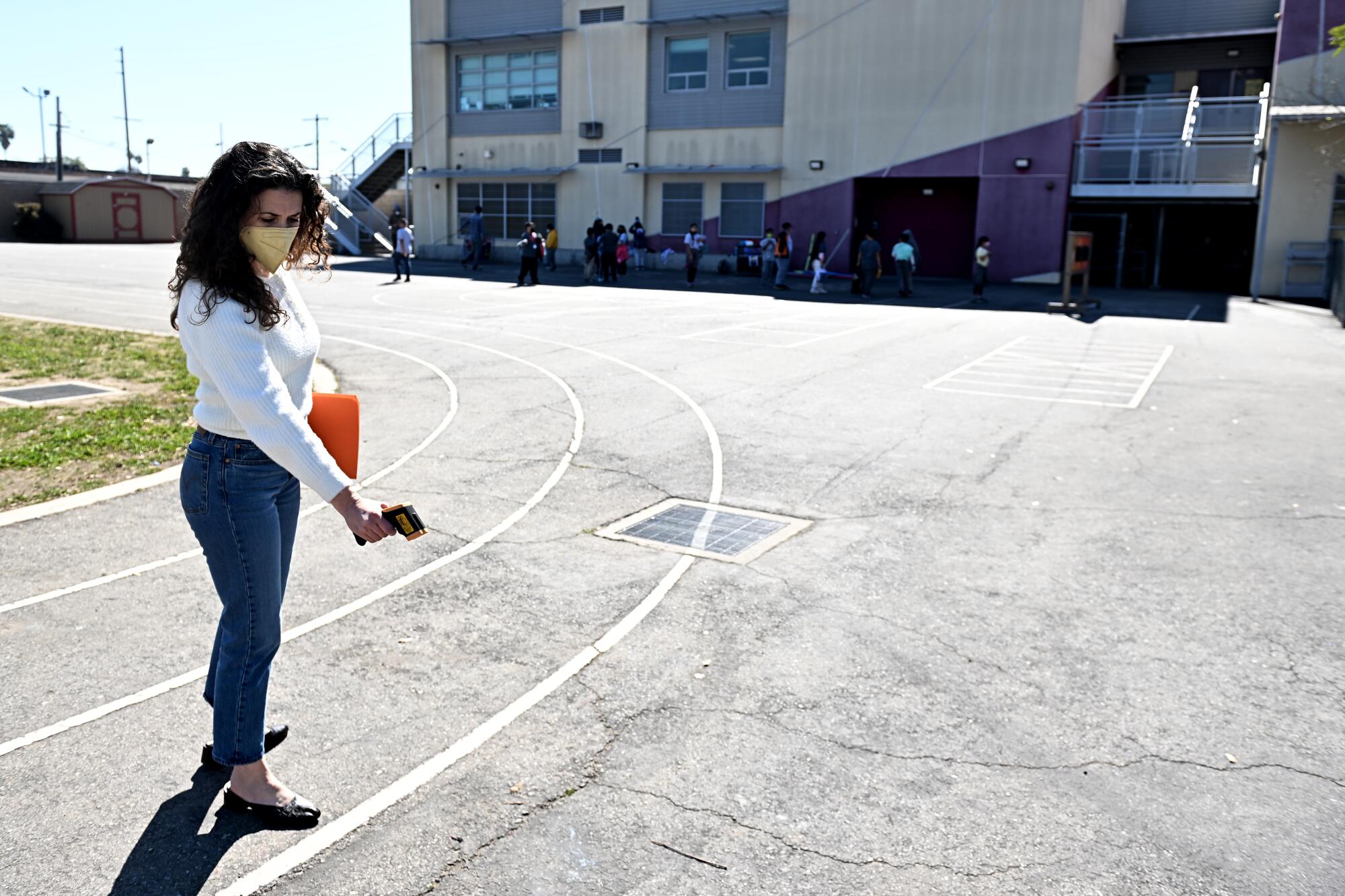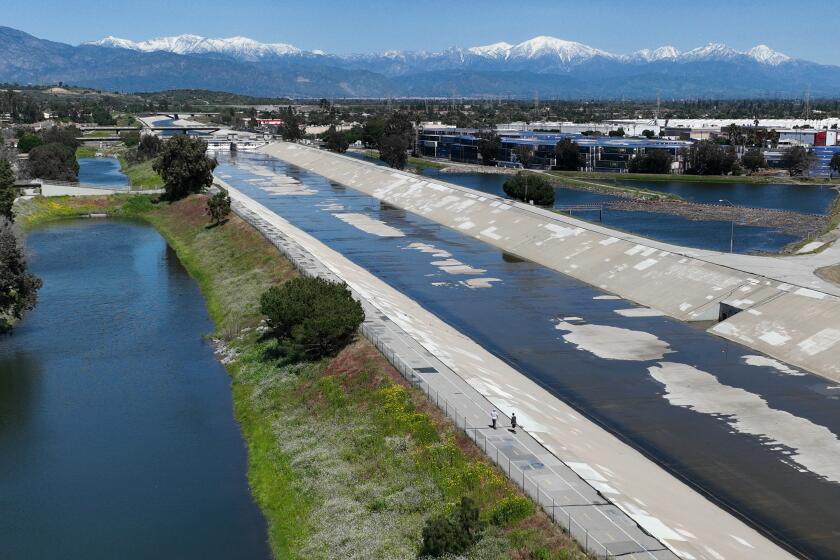
- Share via
As California looks to improve its ability to capture and store stormwater throughout the state, there is at least one sizable public landowner that is exempt from such efforts: The Los Angeles Unified School District.
One of the largest real estate holders in the Greater L.A. area, the school district owns more than 3,200 parcels of land that occupy more than 10 square miles combined — an area almost twice the size of Beverly Hills.
Now, environmental groups are urging state water regulators to include the district’s K-12 campuses in updated stormwater regulations, saying that LAUSD could make a considerable contribution to reducing pollution and enhancing water supplies in the region.
“Schools have been unregulated for runoff pollution for far too long,” a coalition of local groups wrote in a recent letter to the State Water Resources Control Board. The groups include the Los Angeles Waterkeeper, Heal the Bay, the Nature Conservancy, the Natural Resources Defense Council and others.
Aggressive and impactful reporting on climate change, the environment, health and science.
They noted that it’s been about a decade since the board last updated its stormwater regulations, known as MS4 permits. The board is now drafting an update to the rules, and the coalition says it is imperative that campuses be included.
“Once again, exempting K-12 schools from the [permit] will allow the wholly inadequate regulation of runoff from schools to continue for years more, and this lack of regulation will not provide the needed pressure to bring school districts like LAUSD to the table to pursue green stormwater projects in a significant and meaningful way,” the letter said.
According to the coalition, more than 580 miles of rivers, streams and shorelines throughout the region are impaired by one or more pollutants — as are 99% of enclosed waterways and wetlands — and urban and stormwater runoff is the largest source of those contaminants.
What’s more, many school campuses are home to considerable amounts of asphalt and other impervious surfaces that not only block stormwater from seeping into the ground and funnel contaminants into the watershed, but also contribute to hotter temperatures for students and their surrounding neighbors.
“Schools do not have to worry about what comes off their facilities,” said Bruce Reznik, executive director of the Los Angeles Waterkeeper. Candy wrappers, chip bags and other refuse regularly wind up in the watershed, as do pesticides and herbicides from lawns and horticulture programs. Copper, zinc, grease and other discharge from cars in school parking lots flow into the watershed as well, he said.
“They don’t have to worry about it at all, and so it doesn’t put the pressure on them to try to do more greening,” Reznik said. Los Angeles already has fairly robust stormwater regulations for most other sectors, so schools are “really the only game changer left,” he added.
Children shouldn’t be forced to learn and play in hot, asphalt-covered, fenced-in campuses, especially in neighborhoods that already lack park space.
But LAUSD officials said their exemption from state regulations does not equate to inaction.
The district complies with the state’s stormwater pollution prevention plan and has developed internal guidelines for new facilities and redevelopment projects, according to Christos Chrysiliou, LAUSD’s chief eco-sustainability officer. The district has also drafted a stormwater whitepaper and technical manual, and passed a 2022 resolution to increase green space on campuses by 30% by 2035.
“We do care about the environment and the students and staff that we serve, so we always try to not just do what’s required, but try to do the best that we can for the environment,” Chrysiliou said. At the same time, “we believe that this is an ongoing and future commitment that can be effectively carried out by the school district by means other than through coverage under the MS4 permit,” he said.
Complying with the permit regulations would eat up additional costs and resources and create undue hardship for the district, he said. For example, the regulations would require them to track and submit data following every rain event.
“We’re already complying with the spirit of the [permit], and adding additional paperwork definitely will take resources and staff from other plans that we have,” he said.
When it comes to stormwater capture, California stands out for “untapped potential,” according to the Pacific Institute.
Officials with the state water board said K-12 schools have not traditionally been included in the stormwater regulations because it’s not required by the U.S. Environmental Protection Agency, which oversees the National Pollutant Discharge Elimination System program.
“The Water Boards are working with state and local officials and interested parties to better understand the potential costs and logistical challenges of including schools in any updated regulations,” agency officials said in a statement. “This is necessary before we can consider an update to the regulations.”
The board is supposed to revisit the MS4 permits every five years, but the update will represent the first in about a decade. They hope to release an informal draft permit this summer or fall, which will be subject to stakeholder feedback.
“While it is true that large, impervious surfaces (like those found at some schools) represent an opportunity to green communities and reduce stormwater pollution, there are logistical and financial challenges to evaluate before the board can consider including schools in a future permit,” the agency said. “The Water Boards are meeting with state and local officials and other interested parties to learn about these factors.”
Advocates acknowledged that many schools are already stretched for funding, and that having to design, implement and run a stormwater program could be a heavy lift. However, there are ample programs and funding sources available to help with such endeavors, including the Safe Clean Water Program, passed by L.A. County voters as Measure W in 2018, which allocates $280 million annually to stormwater capture programs, the coalition’s letter says.
L.A. County has captured enough stormwater to supply an estimated 2.4 million people for a year. Officials say they plan to capture more runoff in the future.
Part of the problem with exempting school districts from the permits is that it makes it difficult to know exactly how much runoff pollution is coming from campuses throughout the county, the letter says.
But Chrysiliou said LAUSD recently developed a database that tracks stormwater device locations so that they can be properly maintained. The devices include filtration tanks, bioswales (depressions or trenches that channel runoff) and permeable pavement installations at more than 120 schools.
He pointed to recent stormwater projects at Northridge Middle School and Daniel Webster Middle School in Sawtelle as examples of such work. Both campuses installed bioswales, rain gardens and permeable paving in recent years.
Reznik acknowledged that such efforts can help, but said they should be district-wide and not piecemeal.
Benefits of the work go far beyond water quality and supplies, he argued. Studies have shown that removing pavement and installing green space can mitigate the impacts of extreme heat and improve overall student performance and physical and mental health, he said.
“I don’t want to make the schools the villains. They’re out there trying to educate students, they do always have budget shortfalls, it’s hard to maintain facilities, and now we’re adding this new thing,” said Reznik of Los Angeles Waterkeeper. “But it’s just too … important for the region — and for the students — to be at the status quo that we’re at now.”











